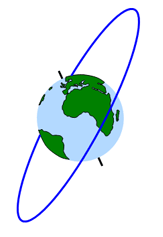Geosynchronous orbit
From Halopedia, the Halo wiki
| This article does not have enough inline citations and/or does not adhere to the proper citation format. You can help Halopedia by adding citations. |
| There is more information available on this subject at Geosynchronous orbit on the English Wikipedia. |
A geosynchronous orbit is an orbit around a planet with an orbital period matching the planet's sidereal rotation period. The term geosynchronous can be used to describe any orbital pattern with a period equal to that of its orbiting body, and in the same direction as the parent's rotation, but is specifically used for orbits with no inclination and a semimajor axis of equal length to the minor axis (i.e. circular). Satellites in geosynchronous orbits appear to maintain their longitude, while their latitude oscillates in a 24-hour period. The geosynchronous orbit over the equator is called the geostationary orbit. Satellites in the geostationary orbit appear stationary relative to the planet's surface.
Uses[edit]
Orbital defense platforms in particular make use of geosynchronous orbits to protect the planet they orbit from attack.[1] The terminus stations of space elevators are also anchored to a geosynchronous, near-geostationary orbit.[2]
Sources[edit]
- ^ Halo 2, campaign level The Armory
- ^ Halo Waypoint: Space Tether
